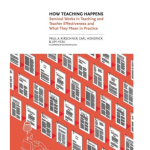I’ve written before that edu-Twitter can be a great help to teachers. I myself regularly learn about fascinating research, and practical teaching applications, from the wise accounts I follow.
Of course, Twitter is also notorious for its edu-nonsense. (No claim about learning styles is too outlandish for the little blue bird.)
I ran across a tweet thread recently that captured this complexity; it strikes me as a healthy reminder of Twitter’s features and foibles.
Here’s the story…
Extraordinary Creativity
A well-known tweep (with 10s of thousands of followers) recently recounted the following story:
An engineer who specialized in designing racing-car engines saw a contest to devise an advertising slogan.*
On a whim, he decided to enter. Drawing on principles from engine design, he conjured up an out-of-left-field slogan that captured public imagination and made the product a best seller.
Now a newly minted ad-executive, this engineer embodies the “positive manifold” as described by psychologist Charles Spearman.
In brief, the “positive manifold” suggests that the strengths of cognitive abilities are correlated; so, skill at race-car design correlates with skill at devising advertising slogans.
In other words, the tweep writes, “expertise gained through specialization is transferrable.”
This story captures several themes beloved by twitter – especially the joyous flexibility of creativity. Skill at anything, in this school of thought, benefits skill at anything else – because “expertise gained through specialization is transferrable.”
When applied to schooling, this argument suggests that students don’t need to learn any particular stuff.
As long as students are learning something, the expertise they gain by learning that something will help them everywhere else. (Again: expertise is transferrable.)
Early Doubts
This approach to creativity has lots of appeal. However, research has tended to contradict it.
Here’s why:
The human mind includes several alarming cognitive bottlenecks.
On the one hand, our long-term memory is functionally infinite. We can know and remember an astonishingly large amount of stuff – both skills and procedures.
On the other hand, the part of the mind that combines pieces in new ways is alarmingly small.
This cognitive function, called “working memory,” just doesn’t have much space.
For instance:
If I ask you to put FIVE random words into alphabetical order in your head, you can probably do so easily enough.
If, however, I ask you to put TEN random words into alphabetical order, your working memory will start smoking and (temporarily) explode.
Creativity, of course, requires combining pieces in a new order – that is: it requires working memory.
Unless someone has organized and consolidated a VAST amount of information in long-term memory, it will be difficult to execute this highly demanding working memory task.
In other words: this story about an engineer-turned-ad-executive sounded really unlikely.
Contra the tweep’s claims, expertise gained through specialization is NOT transferrable to another specialty. Knowing a great deal about racing-car engines almost certainly doesn’t help create catchy advertising slogans.
Not So Fast
Cognitive scientists generally agree that expertise can’t be transferred, and that creativity requires lots of expert background knowledge.
But remember: the tweep has cited Spearman’s “positive manifold.”
In fact, he notes that a well-known Learning and the Brain speaker has written about the positive manifold.**
If my own organization is touting this concept, surely I should value its application.
Now I have an embarrased confession:
I’ve never even heard of the “positive manifold.”
Given my alarming ignorance, perhaps I should simply admit my prior beliefs about transfer and creativity were wrong.
Instead, I looked up “positive manifold.”
Turns out: the positive manifold has NOTHING TO DO with transfer of expertise.
Spearman found that various measures of intelligence correlate with one another. People who study intelligence write about “g” — a “general intelligence” — because the various subscales on intelligence correlate.
Of course, that finding does not remotely suggest that expertise in race cars correlates with (or causes) expertise with advertising. Spearman never said any such thing.
He was investingating the NARROW topic of intelligence testing, not the BROAD question of creativity and transfer.
But wait: what about that Learning and the Brain speaker?
Sure enough, his book devotes about a page and a half to “positive manifold.” Those pages explain that various measures of intelligence correlate — and says nothing whatsoever about creativity, or about transfer of expertise.
Savor the Irony
Here’s the larger perspective: someone who clearly has Twitter expertise (10s of thousands of followers) claims to have another kind of expertise: expertise in creativity and psychology research.
However, his first kind of expertise does not transfer to the second kind of expertise. He doesn’t know enough about psychology to know how little he knows. (This mistake might sound like Dunning-Kruger to you…)
And so, when he writes that “expertise gained through specialization is transferrable,” we should notice that:
First: he’s almost certainly wrong, and
Second: his own tweet thread is an example of his very wrongness. His expertise did not transfer.
I should note, by the way, that I haven’t investigated the story about the engineer. It’s possible, I suppose, that lightning struck in this one case.
However, teachers and school leaders should absolutely NOT act as if this one anecdote matters for education or curriculum design.
And this episode should remind us: Twitter can offer intriguing suggestions…but we should always investigate them skeptically.
* As is typical on this blog, I’m not identifying the tweet I’m criticizing. My goal is not to name/shame an individual, but to raise alarms about common practices. This tweet is just one example.
** Again: I’m being vague so as not to identify the tweet.




